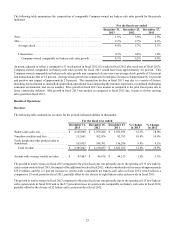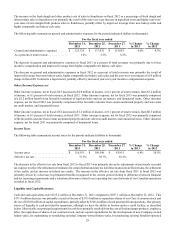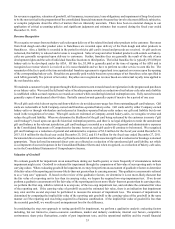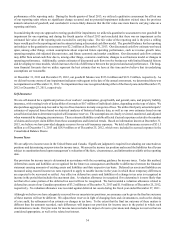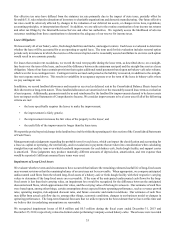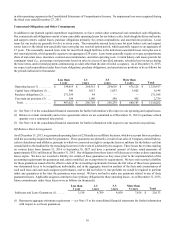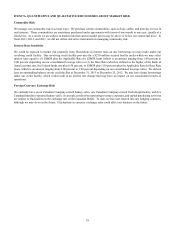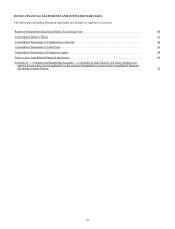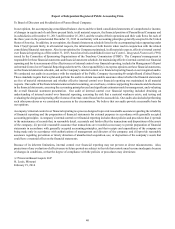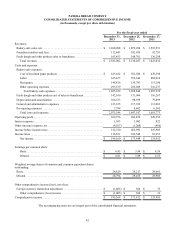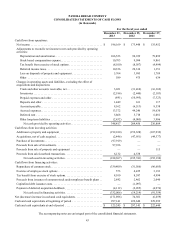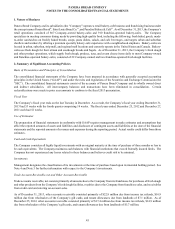Panera Bread 2013 Annual Report Download - page 43
Download and view the complete annual report
Please find page 43 of the 2013 Panera Bread annual report below. You can navigate through the pages in the report by either clicking on the pages listed below, or by using the keyword search tool below to find specific information within the annual report.35
Our effective tax rates have differed from the statutory tax rate primarily due to the impact of state taxes, partially offset by
favorable U.S. rules related to donations of inventory to charitable organizations and domestic manufacturing. Our future effective
tax rates could be adversely affected by changes in the valuation of our deferred tax assets, or changes in tax laws, regulations,
accounting principles, or interpretations thereof. In addition, we are subject to the routine examination of our income tax returns
and other tax filings by the Internal Revenue Service and other tax authorities. We regularly assess the likelihood of adverse
outcomes resulting from these examinations to determine the adequacy of our reserve for income taxes.
Lease Obligations
We lease nearly all of our bakery-cafes, fresh dough facilities and trucks, and support centers. Each lease is evaluated to determine
whether the lease will be accounted for as an operating or capital lease. The term used for this evaluation includes renewal option
periods only in instances in which the exercise of the renewal option can be reasonably assured and failure to exercise such option
would result in an economic penalty.
For leases that contain rent escalations, we record the total rent payable during the lease term, as described above, on a straight-
line basis over the term of the lease, and record the difference between the minimum rent paid and the straight-line rent as a lease
obligation. Many of our leases contain provisions that require additional rental payments based upon net bakery-cafe sales volume,
which we refer to as contingent rent. Contingent rent is accrued each period as the liability is incurred, in addition to the straight-
line rent expense noted above. This results in variability in occupancy expense over the term of the lease in bakery-cafes where
we pay contingent rent.
In addition, we record landlord allowances and incentives received as deferred rent in the Consolidated Balance Sheets based on
their short-term or long-term nature. These landlord allowances are amortized over the reasonably assured lease term as a reduction
of rent expense. Additionally, payments made by us and reimbursed by the landlord for improvements deemed to be lessor assets
have no impact on the Statements of Comprehensive Income. We consider improvements to be a lessor asset if all of the following
criteria are met:
• the lease specifically requires the lessee to make the improvement;
• the improvement is fairly generic;
• the improvement increases the fair value of the property to the lessor; and
• the useful life of the improvement is longer than the lease term.
We report the period to period change in the landlord receivable within the operating activities section of the Consolidated Statements
of Cash Flows.
Management makes judgments regarding the probable term for each lease, which can impact the classification and accounting for
a lease as capital or operating, the rent holiday, and/or escalations in payments that are taken into consideration when calculating
straight-line rent and the term over which leasehold improvements for each bakery-cafe, fresh dough facility, and support center
is amortized. These judgments may produce materially different amounts of depreciation, amortization, and rent expense than
would be reported if different assumed lease terms were used.
Impairment of Long-Lived Assets
We evaluate whether events and circumstances have occurred that indicate the remaining estimated useful life of long-lived assets
may warrant revision or that the remaining balance of an asset may not be recoverable. When appropriate, we compare anticipated
undiscounted cash flows from the related long-lived assets of a bakery-cafe or fresh dough facility with their respective carrying
values to determine if the long-lived assets are recoverable. If the sum of the anticipated undiscounted cash flows for the long-
lived assets is less than their carrying value, an impairment loss would be recognized for the difference between the anticipated
discounted cash flows, which approximates fair value, and the carrying value of the long-lived assets. Our estimates of cash flow
were based upon, among other things, certain assumptions about expected future operating performance, such as revenue growth
rates, operating margins, risk-adjusted discount rates, and future economic and market conditions. Our estimates of cash flow
may differ from actual cash flow due to, among other things, economic conditions, changes to our business model or changes in
operating performance. The long-term financial forecasts that we utilize represent the best estimate that we have at this time and
we believe that its underlying assumptions are reasonable.
We recognized impairment losses of $0.8 million and $0.3 million during the fiscal years ended December 31, 2013 and
December 25, 2012, respectively, related to distinct under-performing Company-owned bakery-cafes. These losses were recorded


